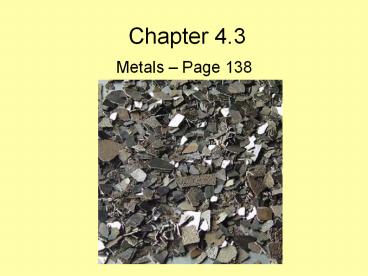Metals - PowerPoint PPT Presentation
Title:
Metals
Description:
Chapter 4.3 Metals Page 138 The Metals Chemical Properties of metals: Some metals are very reactive (Na) and others are very unreactive (Au and Pt). – PowerPoint PPT presentation
Number of Views:41
Avg rating:3.0/5.0
Title: Metals
1
Chapter 4.3
- Metals Page 138
2
The Metals
- Chemical Properties of metals
- Some metals are very reactive (Na) and others are
very unreactive (Au and Pt). - The metals in Group 1 are the most reactive
- Metals usually react by losing electrons to other
atoms.
3
Alkali Metals
- Group 1, all have one valence electron
- These react with other elements by losing one
electron. Highly reactive. - Many alkali metals are soft, shiny and can cut
with a knife.
4
Alkaline Earth Metals
- Group 2, two valence electrons
- Properties fairly hard metals, good conductors
of electricity
5
Transition Metals
- Groups 3 12
- Less reactive as you move from left to right
- Most transition metals are hard metals, shiny and
good conductors of electricity
6
Metals in Mixed Groups
- Metals in Groups 13-15 (not all are metals in
these groups) - Most common are aluminum, tin and lead
7
Lanthanides
- This row of elements is separated to make the
Periodic Table more compact. - Neodymium (Nd) is used to made strong magnets
8
Actinides
- Most of the elements in this series have been
created artificially in laboratories - The nuclei of these many of these elements tend
to be unstable - Uranium is the most common naturally occurring
element in this series
9
Synthetic Elements
- These include the elements with an atomic number
greater that 92 - These are made by scientists forcing nuclear
particles to crash into one another with the use
of a particle accelerator
10
Chapter 4.4
- Nonmetals, Semimetals, Inert Gases
11
The Nonmetals
- A nonmetal is an element that lacks most of the
properties of a metal. - Most nonmetals are poor conductors of electric
current and heat. - Solids nonmetals are dull and brittle!
12
Physical Properties of Nonmetals
- Four nonmetals are gases at room temperature.
- Oxygen, nitrogen, Fluorine and Chlorine
- Bromine (Br) is the only nonmetal that is a
liquid at room temperature. - Other nonmetals are such as Sulfur (S) are solids
at room temperature. - Solid nonmetals are dull, brittle, and poor
conductors of heat and electric current.
13
Chemical Properties of Nonmetals
- Atoms of nonmetals usually gain or share
electrons when they react with other atoms. - When nonmetals react, electrons move from the
metal atoms to the nonmetal atoms. - Example
- Na (metal) Cl (nonmetal) --gt NaCl (salt)
14
Nonmetal Families
- The Carbon Family element can gain, lose or
share 4 electrons. - The Nitrogen Family elements can gain or share 3
electrons. This group is reactive, however not as
much as the Oxygen family - The Oxygen Family elements can gain or share 2
electrons. This group is very reactive. - The Halogen Family Halogensalt forming.
Elements can gain or share 1 electron. This is
the most reactive group of nonmetals.
15
Inert Gases
- Group 18 elements are known as the inert gases.
- These elements do not form compounds because they
cannot gain, lose or share electrons. - The inert gases are also known as the noble gases.
16
The Semimetals
- Semimetals have some of the properties of metals
and some of the properties of nonmetals. - All semimetals are solid at room temperature.
- They are brittle, hard and somewhat unreactive.
- The most common semimetal is Silicon (Si), a
component in glass (SiO2). - The most useful property of the semimetals is
their varying ability to conduct electric
current. - Semimetals are good examples of semiconductors,
substances that conduct electric current under
some conditions but not under other conditions.































